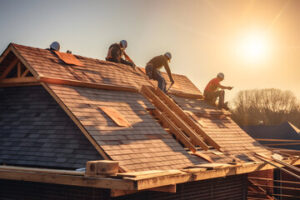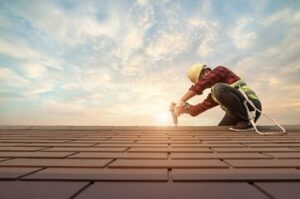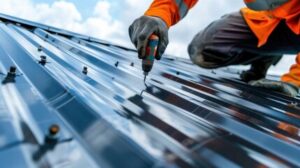A roof is a crucial part of any structure. It protects against rain, snow, sunlight, and wind.
Roofing is also about ventilation, which allows moisture to escape and prevents mold and mildew. A roof should have gutters and eaves to drain water away from the fascia, rafter, and trusses to protect against wood rot. Contact Erie Roofing Company now!

Thatching is a traditional method of covering roofs. It is a natural, long-lasting, attractive roofing material. It can be made from various materials, including water reed and black ijuk fibres, and can be used for both new and repaired roofs. It is also more cost-effective than tiling, as thatching requires less timber in the roof structure to support it.
In its most common form, thatching is the application of a layer of combed wheat or rye straw to a rafter-supported roof. The thatch is held in place by ‘fixings’ – either a crook driven into the thatching at regular intervals along each rafter (standard thatching) or by weighted wire netting which is attached to the rafters (Directional thatching).
A thatched roof is a natural insulator, as air pockets within the straw thatch act to keep buildings cool in summer and warm in winter. It also provides a high level of protection from rain, snow, sun and cruel UV rays.
Thatch can develop if a lawn produces more organic matter than it can break down, or if soil conditions are poor and do not allow for good microbial activity. Excessive thatch allows moss and weeds to take hold, and it also creates the ideal breeding ground for lawn diseases and pest infestations. De-thatching in spring and autumn helps to prevent excessive thatch build-up by allowing grasses to recover before their peak growing period in summer and before going dormant over winter.
Clay Tiles
Clay tile is a highly durable material that resists the ravages of time and the extremes of weather conditions. Its lifespan exceeds 100 years, making it a cost-effective investment for homeowners. It also reduces the probability of frequent roof repairs.
Clay tiles are available in a wide variety of styles that complement many different architectural preferences. They are often glazed to resist water penetration and UV rays. They are heavier than other roofing materials, so the design of a roof structure must take these additional weights into consideration.
Unlike asphalt shingles, which expand and contract based on outdoor temperatures, clay tiles remain stable. They also reflect sunlight, providing a cooling effect in summer and lowering energy costs. Light-colored terra cotta tiles can even help save on heating bills by reflecting more solar radiation than dark-colored shingles.
Because clay is a natural material, it does not deplete the planet’s natural resources and is an eco-friendly choice for homeowners concerned about environmental impact. It also has inherent fire-resistant properties, a major benefit for homes located in wildfire prone regions. In addition, it complies with California’s stringent fire safety standards and often meets local regulations regarding aesthetics and material requirements.
Its durability means that clay tiles are a popular choice for constructing high-rise buildings and other commercial structures. They can withstand severe climatic conditions such as heat waves and heavy rainfalls, and they offer superior wind resistance. Clay tile is also resistant to fire and corrosion, making it a safe and long-lasting material for construction projects in any environment. However, it requires careful maintenance to prolong its life and performance. It is advisable to have a professional inspect it once every year for moss growth, mildew, cracked tiles and other signs of problems.
Slate
Slate is a gorgeous roofing material with incredible longevity. It will outlast most other roof materials, meaning that you’ll spend less on repair and replacement down the road. Additionally, slate roofs add value to your home and make it more appealing to potential buyers.
Slates are a type of rock that is mined throughout the world and is used for a variety of purposes, including flooring, laboratory tabletops, roofing, and blackboards. Slate can be found in a range of colors, from light to dark grey, and is naturally durable and weatherproof. It’s also easy to cut, so it’s suitable for various roofing styles.
While there are a wide variety of roofing materials available, slate is often chosen for historic and upscale homes because of its durability and aesthetics. It’s also a green roofing option because it doesn’t require any form of manufacturing, and it’s made from natural, sustainable resources.
Ideally, a slate roof should be constructed with proper headlap and exposure to minimize the risk of water infiltration through side joints and nail holes. This is especially important on steeper roofs where the flow of rainwater can be fast.
If you’re considering slate for your roof, it’s important to choose a skilled roofing contractor who will follow the proper installation techniques. For example, slate should be installed over a metal cricket, and the flashing should extend at least 6” from the wall of the house to prevent rainwater from entering at penetrations.
It’s also important to install slates in a uniform manner and avoid cutting or altering them in any way, as this could affect the lifespan of your roof. It’s also important to install proper counter-flashing at chimneys and pipe penetrations.
Flat Roofs
Flat roofs aren’t a relic of the past, and they can look great on modern homes with the right design. They’re also cheaper to install and maintain than sloped roofs, and can help reduce energy bills. If you opt for a flat roof, be sure to work with a skilled and reliable contractor who will ensure that the construction is safe, durable and airtight.
With a flat surface, flat roofs are often associated with commercial buildings, but they’re increasingly being used for residential structures as well. They can be made from a wide range of materials, including EPDM, PVC and TPO, but the best choice depends on your needs and budget. Using the right roofing materials will protect your property from harsh weather conditions and ensure that water runs off quickly without pooling.
Because they require fewer materials than sloped roofs, flat roofs tend to be less expensive to build and repair. They can also be installed more quickly, which is helpful for building owners who want to minimize the amount of time their business’s operations are interrupted during the roofing process.
Unlike sloped roofs, which have eaves, flat roofs don’t have these edges that hang over the walls of a structure, which gives them a more streamlined appearance. Their spacious nature also makes them ideal for installing mechanical equipment, as well as solar panels and rooftop gardens, which can contribute to reduced energy costs. The use of reflective materials on flat roofs can further help to keep energy bills low by preventing heat absorption and minimizing the need for air conditioning during warm weather seasons. The spaciousness of a flat roof also offers the potential to create additional living space in your home, such as a patio or garden.
Agable Roofs
Gable roofs are an attractive choice for many homeowners, and they blend with a variety of architectural styles. Their triangular shape adds a touch of elegance and appeal to homes, while the steep slopes allow for ample attic space. These extra rooms can be transformed into cozy reading nooks, additional bedrooms, creative studios, or whatever else you imagine for your home.
Because gable roofs have a larger surface area, they provide better ventilation than other roof designs. However, this type of roof requires regular maintenance to prevent damage from heavy winds and storms. You might find yourself calling your local roofing contractor on a more frequent basis, as you’ll need to replace shingles and reseal areas around chimneys and dormers.
In addition, a gable roof’s sloped design allows rain and snow to slide easily off the surface of the roof. This can prevent water accumulation that may lead to leaks. This can also help extend the lifespan of your roof and reduce repair costs.
Gable roofs are also easy to customize, allowing you to create the perfect look for your home. There are various variations to this roof style, including a Dutch gable (which features two gable roofs with ridges perpendicular to each other) and a cross gable (which is designed with two gable roof sections). Queen Anne and Victorian-style houses also feature gable roofs, which can be embellished with gingerbread trim and towers.



